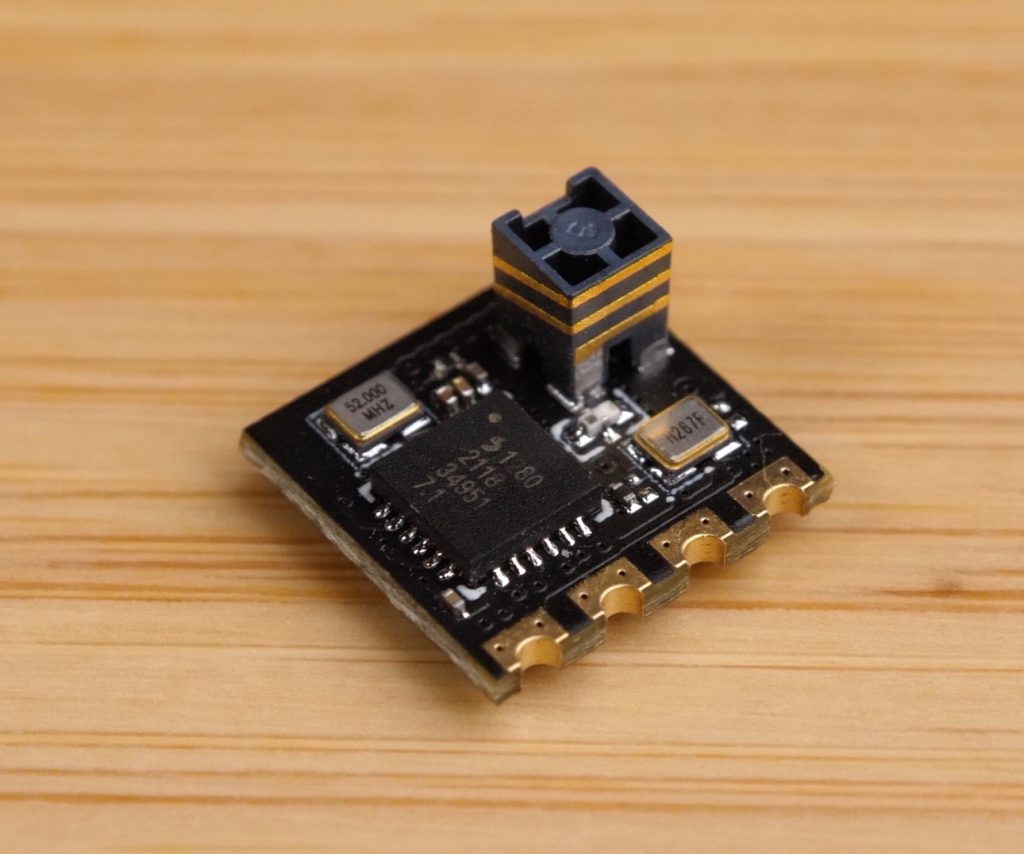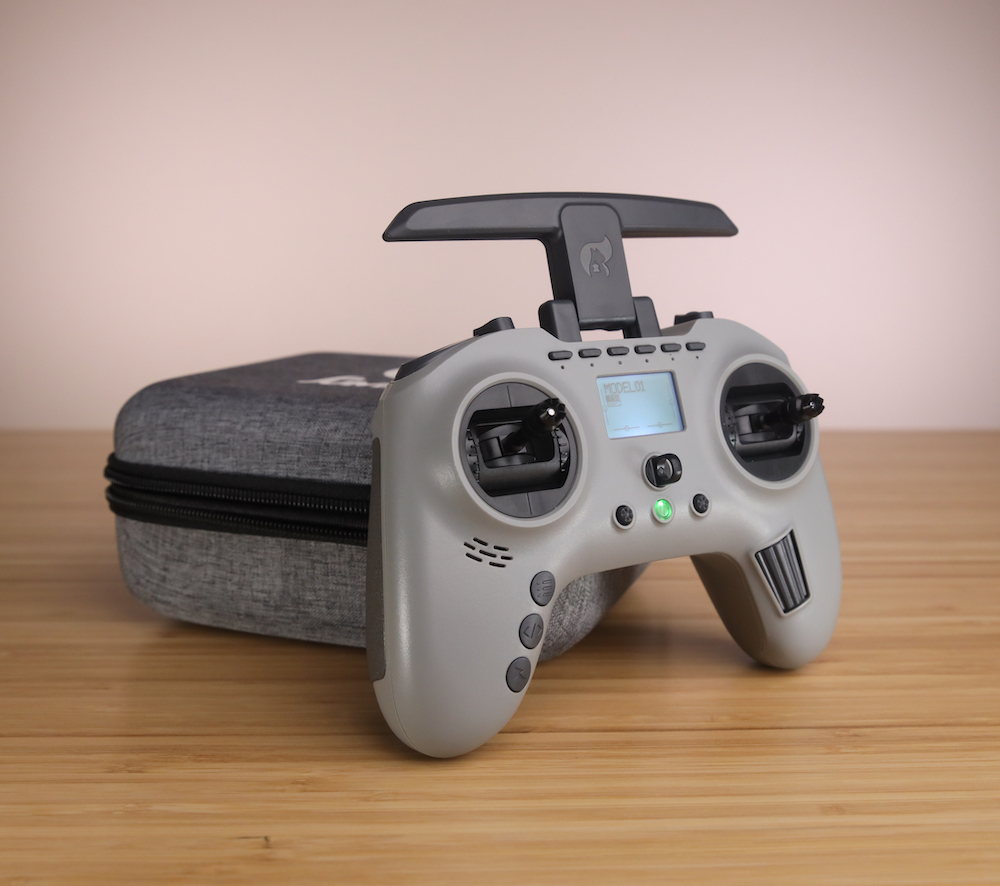
ExpressLRS, or ELRS, is an open-source radio control protocol. It offers a number of features that make it an appealing option for use on FPV drones. In this article, I will explain the major benefits of ELRS, compare it to other radio control link options, and give you an overview of what you would need to get started with it.
I won’t be covering the inner technical workings of the ELRS hardware and protocol on this page. Instead, I’m going to focus on how it interacts with FPV drones and how you would use it for your own flying. Since ELRS is open-source, if you’re interested in the technical details, all of that information is available. See the ExpressLRS site <link> for more.
915 MHz or 2.4GHz?
ELRS is available in two main forms: 915 MHz ( 868 MHz in some areas), and 2.4 GHz. The difference is fairly simple. The ~900 MHz version offers longer range, but at the cost of requiring larger antennas. The 2.4 GHz version offers a bit less range, but can use much smaller antennas.
2.4 GHz ELRS has become much more common than 900 MHz ELRS, to the point that I would not recommend using the 900 MHz version unless you plan to regularly fly at ranges of dozens of miles. You will have a much easier time finding equipment for 2.4 GHz ELRS, and it offers more than enough performance for nearly all use cases.
Although many of the benefits of ELRS apply to both frequency ranges, for the rest of this article I will be focusing on 2.4 GHz ELRS.
Advantages of ELRS
ELRS was designed with FPV drones in mind, and has several key advantages for use in FPV. These are the ones that I find most important as a pilot.

Long range performance. ELRS is capable of successfully transmitting a signal over very long distances. With a tested range <link> of at least 40 km (nearly 25 miles), ELRS is capable of transmitting significantly farther than most FPV pilots will ever need. And it’s important to note that this range is important even if you only fly in much smaller areas–the long-range performance also means that ELRS provides excellent performance in areas with dense buildings or trees.
Low latency. ELRS has much lower latency than some other control links, reducing the delay between moving a stick on your radio and having the drone react. You have the ability to trade long-range capability for lower latency by increasing the packet rate of the protocol, up to a maximum of 500 Hz. Even at the highest packet rates, ELRS still offers longer range than many other control links.
Small size. ELRS receivers, which are the component you would install onto an FPV drone, are extremely small and lightweight, coming in at only 0.44g for the smallest version. This is a major benefit for installing onto a remote-controlled aircraft because any reduction in size and weight makes the installation process easier and improves flight performance. The antennas for 2.4 GHz ELRS are equally small, and can even be mounted directly on the board with no need for a wire antenna.
Easy firmware updates. Updating firmware on ELRS is much simpler than many other control links. With options for updating via WifI or USB (with flight controller passthrough), the firmware update process is quick and easy. This means that it’s simple for you to keep all of your ELRS transmitters and receivers up-to-date, and you can immediately take advantage of new features and bug fixes.
Low cost. ELRS transmitters and receivers are cheaper (and in some cases, much cheaper) than most of the competing options. Combined with its excellent performance, this low cost is only a benefit – it’s not a case of “getting what you pay for”, but instead it’s a great product at a very low price. This really adds up if you own many drones or multiple radio transmitters, and is a big benefit to ELRS.
How Does ELRS Compare to Other Control Links?
ELRS is one of several options for radio control links that you can use on FPV drones, and whether you’re choosing a control link for your first drone or trying to decide whether to switch to ELRS, it’s important to compare it to the other options in the market.
In my opinion, here is how ELRS compares to some of the other common control links:
FrSky
Compared to FrSky, ELRS offers dramatically improved range and obstacle penetration. Firmware updates with ELRS are also much easier. Often, when you buy a FrSky receiver, you must update the firmware to a version that is compatible with your radio transmitter. This requires using a special programming device or an FrSky radio, and cannot be done without desoldering the receiver from your drone. In comparison, ELRS allows you to update firmware over WiFi, and also offers backward compatibility so that in many cases, you don’t have to update the firmware to use the receiver with your radio.
Additionally, the binding process is much simpler with ELRS. With FrSky, to bind a new receiver to your radio, you must hold down a button on the receiver while powering it up. This can be challenging depending on where you have installed the receiver. By comparison, with ELRS you can define a “passphrase” in the firmware and use it with all of your receivers and radio transmitters. This passphrase allows the receiver to automatically connect to any radio with the matching passphrase. This makes binding ELRS receivers very easy.
ELRS is really better than FrSky in every way, and I would recommend choosing it over FrSky in all cases. If you’re already using FrSky, you can likely buy an ELRS transmitter module for your radio, which would allow you to use both protocols with the same radio. This allows you to slowly transition all of your drones to ELRS without needing to upgrade everything at once.
Crossfire
While Crossfire offers many of the same benefits of ELRS, including long-range capability and simple firmware updates, it falls short in one major area: price. Crossfire transmitter modules can cost 2-4x as much as an ELRS transmitter module, and the receivers can also be twice as expensive. If you don’t already own Crossfire, this can make it expensive to adopt across a whole fleet of drones.
Compared to 2.4 GHz ELRS, Crossfire antennas are also larger and bulkier due to its 900 MHz protocol. This may not be a concern on larger builds, but it can make installing Crossfire on a whoop or micro drone more challenging.
If you’re already using Crossfire, you may not see value in upgrading to ELRS unless you value the small size of the receivers or expect to greatly expand your drone collection in the future. On the other hand, if you don’t own either system, I highly recommend choosing ELRS over Crossfire. It offers almost all of the same benefits at a lower cost and smaller size.
What ELRS Gear Do You Need?
If you want to use ELRS, you’ll need a way to transmit the signal from your radio, and a way to receive it on the drone. There are many products available for ELRS and new transmitters and receivers continue to release, but I will cover the major decisions you need to make and a few options for each.
Note: The product links on this page are affiliate links. I earn a small commission if you purchase products through these links. For more information, see my affiliate link policy.
Transmitter: Radio or Module

You will need a way to transmit the ELRS signal from your radio to the drone. If you don’t already own a radio for FPV, I’d recommend buying one with ELRS built-in. This is more compact than buying an external module, and in many cases can be cheaper. Two options that I really like right now are the Jumper T-Pro and Radiomaster Zorro. Both of these radios are available with an internal ELRS module, and they are both well-designed radios that are small and easy to use.
View the Jumper T-Pro here:
RaceDayQuads
Makerfire
View the Radiomaster Zorro here:
GetFPV
RaceDayQuads
If you do already own a radio that you’re happy with, it most likely includes a module bay that allows you to attach an external transmitter module for a different protocol. It’s important to determine which type of module you need. There are multiple variants, including a JR (micro) and a nano size. Some radios, such as the Jumper T-Lite, require a special module that isn’t either of these sizes.
Once you know the size you need, there are several ELRS modules to choose from. I typically recommend the Happymodel ES24TX (or ES24TX Pro) modules; I’ve always been happy with their performance, and they come at an affordable price. However, there are options from several other manufacturers, including BetaFPV, Axis, and Namimno.
View the Happymodel ES24TX Pro (JR/micro bay) here:
GetFPV
RaceDayQuads
View the Happymodel ES24TX Slim Pro (nano bay) here:
GetFPV
RaceDayQuads
View the Happymodel ES24TX Lite (Jumper T-Lite) here:
GetFPV
RaceDayQuads
Receiver
You will need a receiver (RX) for each drone you intend to use with ELRS. As ELRS becomes more established, more drones offer support for it out-of-the-box, either by having it built into the flight controller board or by pre-soldering an ELRS receiver. If you’re moving to ELRS for an existing drone or are buying a drone that does not have an ELRS receiver, you will need to purchase and install a receiver.
There are many receiver options available, but they can be grouped into a few major categories.
Integrated Antenna Receivers

These receivers have the antenna soldered directly onto the receiver’s circuit board, which makes them very compact and easy to install into a small drone. Don’t be fooled by the small antenna–these receivers offer excellent performance, and they are the receivers I use most frequently in my builds.
There are several manufacturers that make this style of receiver, but the one I have used most is the Happymodel EP2 receiver.
View the Happymodel EP2 here:
GetFPV
RaceDayQuads
External Antenna Receivers
These receivers have a UFL antenna connector and use an external antenna. This can provide greater range than the integrated antenna receivers, and also can be useful if you intend to bury the receiver deep inside a build, where radio signals may have a harder time penetrating into the body of the drone.
Just as with the integrated receivers, there are several manufacturers making this style, but my main experience has been with the Happymodel EP1. I use this receiver on larger builds where the external antenna won’t be a challenge to mount cleanly onto the drone.
View the Happymodel EP1 here:
GetFPV
RaceDayQuads
PWM Receivers
If your drone doesn’t have a flight controller, as is common on some planes, you’ll need a receiver that has PWM outputs to control servo motors directly. There are a few options for this type of receiver, such as the Mateksys PWM ELRS R24 P.
View the Mateksys PWM ELRS R24 P here:
GetFPV
RaceDayQuads
How to Set Up ELRS
Once you’ve decided to use ELRS and purchased a transmitter and receiver, you will need to solder the receiver to your drone and configure your radio and receiver. While I don’t have a written guide for this yet, I have a video which covers the setup process in detail.